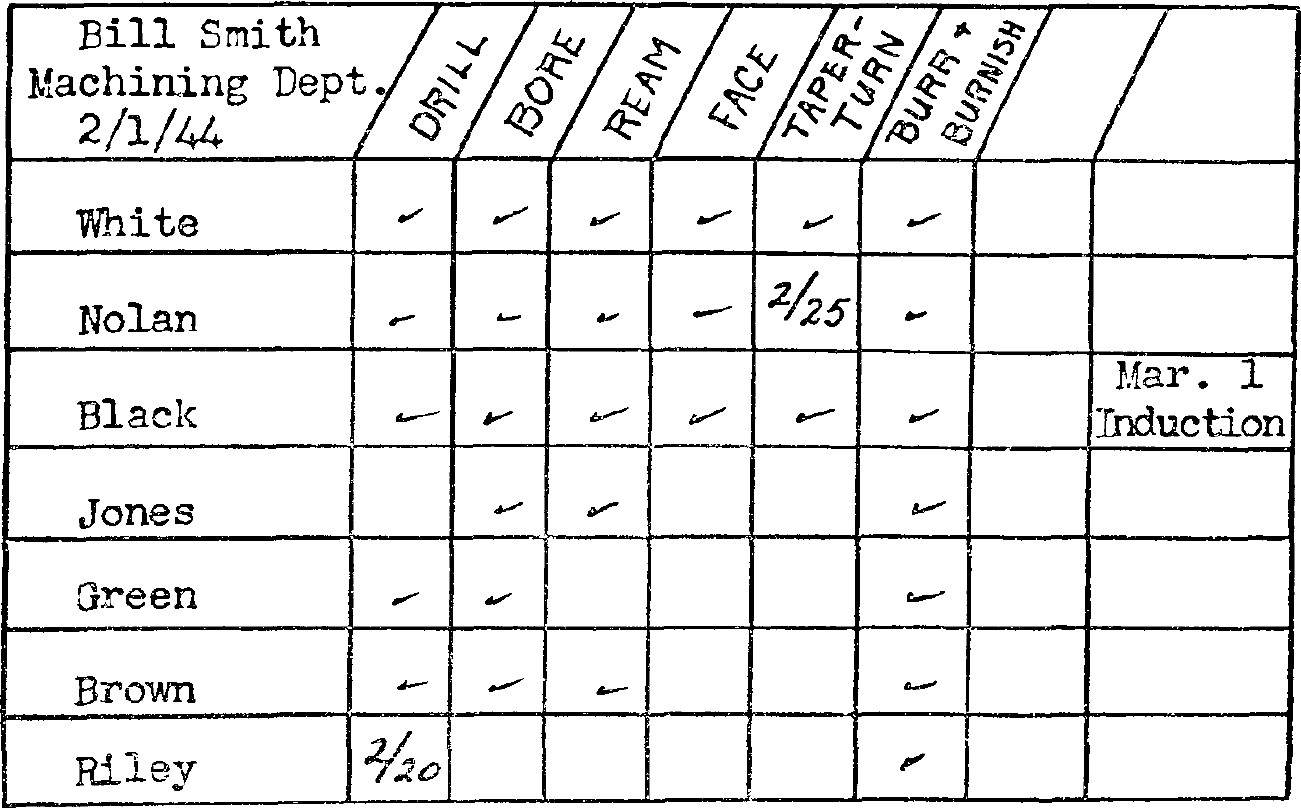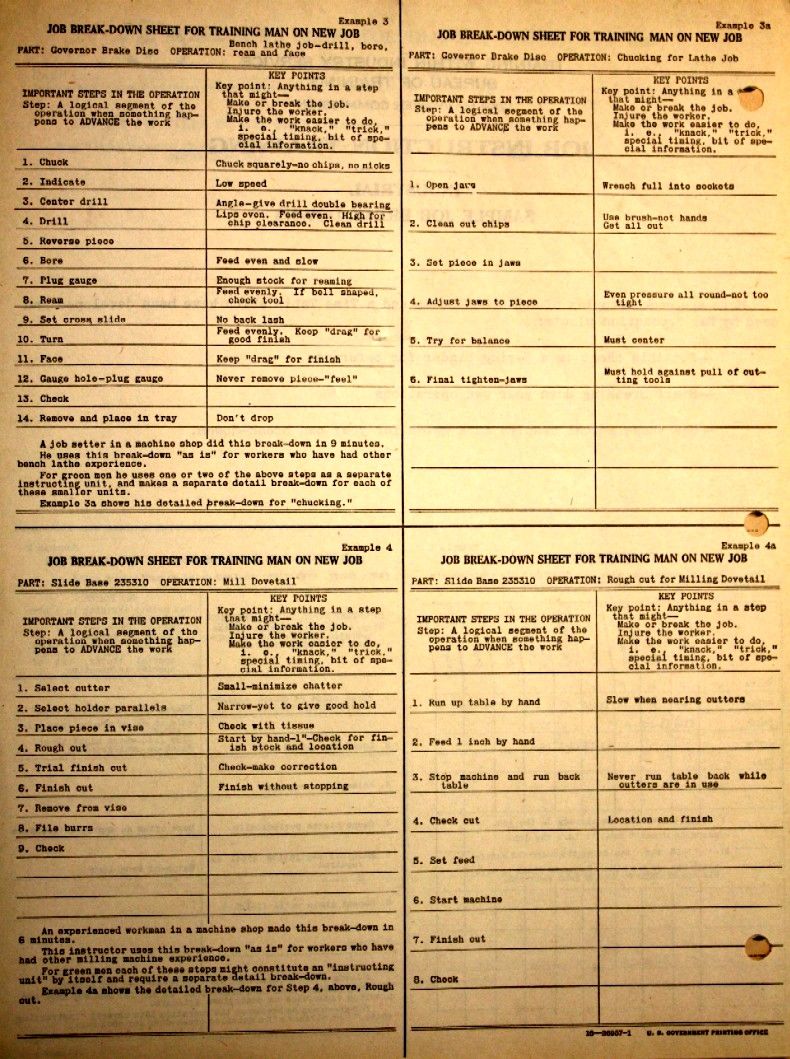 Arguably the most successful module of Training within Industry is Job Instructions, or JI for short. JI has a precise focus on one topic: how to train your workers. The method is very simple and basic but works well.
Arguably the most successful module of Training within Industry is Job Instructions, or JI for short. JI has a precise focus on one topic: how to train your workers. The method is very simple and basic but works well.
Of course, there are some limitations. The process works well with pretty much any type of work, but it is best done one-on-one, as it was intended. It is not well suited for classroom teaching of larger groups; the trainer does need to invest time and attention to every individual student. But overall a very useful method. This is the second in a series of five posts on TWI.
The Fundamentals
Let me start with the fundamental rules. These rules were printed on a small card so the instructor could have them with him all the time. While original cards are hard to find, modern reprints are common. A picture of an original card is shown here
I have written the text below as an introduction. But further below I will go into more details.
How to Get Ready to Instruct
- Have a Time Table: How much skills you expect him to have, by what date?
- Break Down the Job: List important steps, pick out key points (safety is always a key point).
- Have everything ready: The right equipment, material, and supply.
- Have the Workplace Properly Arranged: Just as the worker will be expected to keep it.
How to Instruct
Step 1: Prepare the Worker:
- Put him at ease.
- State the job and find out what he already knows about it.
- Get him interested in learning job.
- Place in correct position (so the learner can see the instructor).
Step 2: Present the Operation
- Tell, show, and illustrate one IMPORTANT STEP at a time.
- Stress each KEY POINT.
- Instruct clearly, completely, and patiently, but no more than he can master.
Step 3: Try Out Performance
- Have him do the job, correct errors.
- Have him explain each KEY POINT to you as he does the job again.
- Make sure he understands.
- Continue until YOU know he knows it.
Step 4: Follow Up
- Put him on his own. Designate to whom he goes for help.
- Check frequently. Encourage questions.
- Taper off extra coaching and close follow up.
Example Instructions
 The TWI Job Instructions Session Outline and Reference Material uses as an example, the fire underwriters knot. This knot was used in electrical wiring to prevent the wires from being pulled out of the housing, which could start a fire, hence “fire underwriter knot.” Nowadays there are much better solutions available, and the knot is not really used anymore. Yet, it serves as a good example for the training.
The TWI Job Instructions Session Outline and Reference Material uses as an example, the fire underwriters knot. This knot was used in electrical wiring to prevent the wires from being pulled out of the housing, which could start a fire, hence “fire underwriter knot.” Nowadays there are much better solutions available, and the knot is not really used anymore. Yet, it serves as a good example for the training.
How to Get Ready to Instruct
So lets get ready to instruct. First, we need to Have a Time Table. Which of your people do you want to train in what by when? Below is the original example from 1945. It is a simple skills matrix about which worker can do what, with two workers who will get trained in drilling and taper turning by a certain date.
Second, we need to Break Down the Job. Below is an image and the corresponding steps of making the fire underwriters knot. The numbers in the list match the numbers in the image. Please note that for your job, the steps should be not every little thing you do, but the main steps needed to do the job.
- Untwist and straighten ends. The key points is that you need about six inches of untwisted wire.
- Make the right hand loop. The key point is that the wire crosses in front of the main strand.
- Make the left hand loop. The key points are that the wire must be pulled toward you, so it goes over the first wire and then passes below the main strand.
- The end of the second wire goes now through the loop of the first wire. (No key points here.)
- Pull the knot tight. The key point is to make the ends even.
Their Job Breakdown form had only two columns, “Important Steps in the Operation” and “Key Points.” Nowadays there is a third column explaining “why” these steps and points are necessary (with credits to the University of Chicago, School of Business around 1967-68). Below are the original (two-column) examples with the original job and the improved job.
Please note that the above list is not yet the method of instruction; we are still in the preparation phase. Before training a worker, we now need to Have Everything Ready and Have the Workplace Properly Arranged.
How to Instruct
For Step 1: Prepare the Worker, we need to get the worker comfortable and interested in the job. We also would need to find out what he knows already about the tasks.
For Step 2: Present the Operation, we show the process to him. We explain the main steps and also the key points. Often, this is done twice so the worker can remember it easier. In the first repetition, you merely state the main steps while doing it; in the second repetition, you also state the key points along with the main steps.
Now in Step 3: Try out Performance, the worker can finally try it out himself. The worker also does the job multiple times. The first time the worker states the main steps. In the second repetition, he also states the key points. Both come from the preparation list above. Repeat this until the worker knows can do and recite all main steps and key points. Naturally you should correct the worker as needed, and also answer his questions. Continue until YOU know he knows it.
In the final Step 4: Follow Up, you check up on the worker’s progress, let him know who to ask if there are questions, and repeat this until the worker is comfortable and stable in his new tasks.
Extensions and Variations

The Job Instructions Session Outline and Reference Material has much more info on the process. It is basically a step-by-step training guide with five sessions of two hours each. Most of it is still very valid today, with a few exceptions.
One exception is that they recommend the trainer to smoke a pipe or cigarette so the participants feel at ease – please don’t do this. Some things HAVE changed since 1945.
For example, the key points of the example above were mostly about the position of the wire. But key points could also be on the feeling of the part or tool, the sound they make, the temperature, special motions or information, and especially safety critical points.
For longer tasks, they recommend breaking the task down into manageable steps and teaching each of them separately. For loud or noisy workplaces, they recommend showing extra care and going to a quieter area for talking if needed. Luckily, many plants nowadays are able to keep the noise down so it is possible to hear each other.
There are different methods of conveying information, namely showing, telling, illustrating using a diagram, and answering questions. The “illustrating” may not be used every time, but it may be an useful addition to the other three if needed.
They also state repeatedly that If the student hasn’t learned, the teacher hasn’t taught. Again, this is a very simple but, in my view, effective method of teaching individuals new skills. The Job Instructions Session Outline and Reference Material is available on multiple locations on the internet, and easy to find with Google. Now, go out, teach your people some new tricks, and organize your industry!
P.S.: Many thanks to TWI Guru Mark Warren for checking the text. He also wrote a series of articles that merges the Trainer’s Guide materials with the Sessions Outline, available online for free.
Series Overview
- Training within Industry – TWI – Oldies but Goldies
- JI: Training within Industry – Job Instructions
- JR: Training within Industry – Job Relations
- JM: Training within Industry – Job Methods
- More on TWI Programs
Sources
 War Manpower Commission. 1944. “Job Instructions Sessions Outline and Reference Material.” War Manpower Commission.
War Manpower Commission. 1944. “Job Instructions Sessions Outline and Reference Material.” War Manpower Commission.
Please note that there is also an updated version available, with updated language and an additional “why” column to the job breakdown sheet by the TWI Guru Mark Warren. It is also much better print than the worn out original typewriter pages:
Mark Warren 2014: “Job Instruction Sessions Outline – 2nd edition.”
Mark Warren: “Job Instructions: 10 hour session outline“, available online & free at Medium.





Hi, Chris,
Exciting learning journey while going through your posts. I’m insterested in collecting this book “Job Instructions Sessions Outline and Reference Material.” 1944 edition. I searched in Amazon.com, but no found. Would you mind recommending me the approach(if available) where to go?
Thanks!
James
Hi James, sent you the (public domain) file by email.